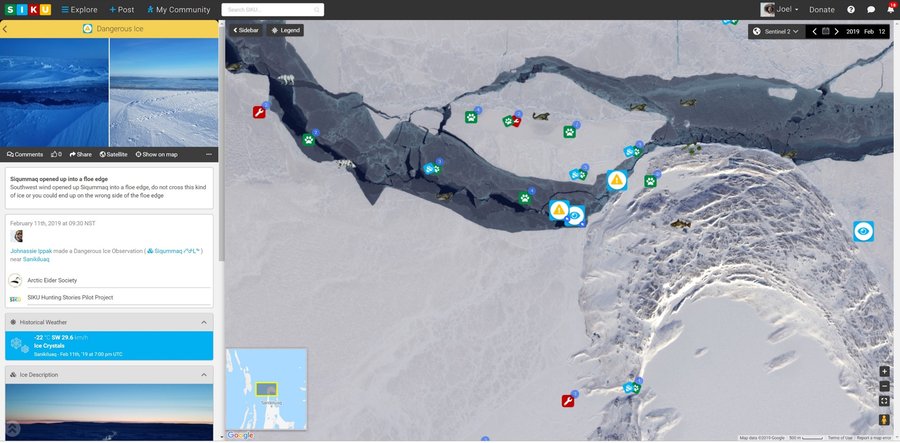
New and innovative forms of knowledge-sharing platforms are urgently needed to overcome the effect profit-driven forces are having on creative online exchange, especially as social media increasingly shapes perceptions of unfamiliar places among younger generations.
Perceptions of the Unfamiliar
The unfamiliar can be daunting, and how we access information about it can either add to feelings of apprehension or facilitate a better understanding. For Generation Z in North America, social media platforms often introduce them to unfamiliar places, providing a technological infrastructure for communication. Unlike previous generations, who relied on one-way communication or were required to travel to learn about the world, we have access to vibrant and instantaneous depictions of places abroad. The ability of social media to shape our perceptions of places around the world signals the importance of evaluating these platforms.
As communications scholar, Christian Fuchs, has pointed out, social media platforms are not neutral couriers, but are developed in the context of societies’ various “crises and antagonisms”. Thinking about social media, as they are developed under the pressures of capitalism, one can better consider how these platforms, by design, privilege certain types of communication and places, while underrepresenting others.

The ability of social media to shape our perceptions of places around the world signals the importance of evaluating these platforms.
A location few Generation Z Southerners will travel, largely due to economic barriers, alongside a lack of knowledge, is the Canadian Arctic – the Northwest Territories, Nunavut, Yukon, and northern parts of numerous provinces. Despite its inaccessibility, the Canadian Arctic needs to be represented to, and understood by, Gen Z southerners; the ongoing climate crises require collaborative planning between people living in the North and South. This case establishes social media as important tools for learning, yet there are two key obstacles to such leverage.
Current social media platforms remain inaccessible to many Northern communities. Andreas Kuersten calls this the Arctic Digital Divide, “the relative deficiency in telecommunications services available to those in the Arctic compared to communities further South.” Illustrating the importance of addressing the Arctic digital divide is Tammy Soanes-White's research, which shows the negative impact of download and upload speeds ranging from 5-35 Mbps for downloads and 1-10 Mbps for uploads in remote regions of Canada, making it "impossible to access" heavy data files at the community level. Persisting through this barrier, the Indigenous Knowledge social network and platform, SIKU, has emerged as a successful alternative, addressing the divide.
The Divide hinders the lives and opportunities of Arctic residents. There is no question that there are barriers restricting participatory exchange of ideas between those living in the North and South, and that we need to broaden access to social media to improve the circulation of knowledge between those living in the North and South.
While some coalition of government is needed to address parity and service issues, the second issue, falling more into the domain of public opinion and political practices, is the one I am interested in taking up: how the economic and political forces of capitalism undermine the social aspect of social media platforms, restricting user ability to engage in creative deliberation and exchanges of knowledge.
Although social media facilitated my learning about the Canadian Arctic and the climate crises burdening Arctic communities, I also observed the limitations of profit-oriented platforms. This experience highlighted the potential of non-profit social platforms to promote democratic and vibrant forms of knowledge exchange – a particularly urgent need in our moment of climate crises, where bridging North-South knowledge, and facilitating learning is essential to understanding and planning how we might navigate the impacts of climate change in the Arctic.
Approaching Arctic Communications
Growing up a settler in Southern Canada, my knowledge of the Canadian Arctic was limited to areas on a map. I learned to think about Yukon, the Northwest Territories, and Nunavut according to the traditions of colonial naming and measurement, seeing their place in relation to the nation of Canada. And as instructed, I saw them as vast uninhabited Northern lands.
Fast forward six years, and I was presented with the opportunity to work as an intern with the Arctic Research Foundation (ARF) and explore research on Arctic science communication. Excited, but daunted by my unfamiliarity with the Canadian Arctic, I accepted. Immediately, this region unknown to me became populated with place names and images of vibrant culture.
My task with ARF focused on sustaining a well-established Northern audience, while expanding the Southern audience of Arctic Focus – an online platform where Arctic explorers, researchers and communities join to share stories of the Arctic. Initially, for the research aspect of the internship project, I sought a better understanding of the composition and circulation of Arctic science stories.

Immediately, this region unknown to me became populated with place names and images of vibrant culture.
Twitter is one of the key platforms used by Arctic Focus to circulate science stories from their website and information about the Canadian Arctic. The platform has played a significant role in my learning over the past ten months. The function of this system is to personalize Twitter feeds by using “historical user data to predict what content or information the user would like to be exposed to in the future” (Smith et al. 592). Identifying and engaging with as many key actors in the field of Arctic science and journalism was step one.
I quickly learned that this system facilitates a kind of gathering, where hashtags and accounts function as meeting spaces. As I scrolled through the profiles of Arctic science researchers, I noticed key hashtags like #SeaIce, and, from the Tweets attached, learned the importance of sea ice as an indicator of climate health, stability, and ecosystems. I learned about the efforts of Oceans North, a group supporting marine conservation in partnership with Indigenous and coastal communities. Science stories and knowledge shared between researchers and users under #SeaIce would have remained unknown to me had I not entered Twitter through the eyes of Arctic Focus.
I reflected on the implications of Twitter’s networking features in a broader context; this rich web of Arctic science stories and research had been here all along, and I had not seen it. Based on my data history and the system’s algorithmic logic, information about the Arctic was not a priority to me.
Douglas Rushkoff anticipates and critiques this reductive outcome, arguing social media feeds are designed to serve the purpose of advertisers rather than encourage nuanced communication and diverse community. Social media are “no longer in the business of delivering people to one another; [they are] in the business of delivering people to marketers” (Rushkoff 32). While I was able to use the recommendation algorithm and personalized feed as a tool to connect me to valuable learning resources via Arctic Focus, it remains undeniable that these platform features serve the interests of platform owners, and aid in the commodification of user data. I am still left wondering which networks of information and people remain hidden from me, as I am delivered to those who are most popular.
Engaging with Arctic Content
As an example of how Twitter can provide helpful connections, but also dead ends, I might cite the connection I made with Arctic freshwater ecologist and PhD student Danielle Nowosad. Still, it was only through conversation with Danielle – an arranged question and answer interview about her work using DNA barcoding in Nunavut – that I learned invaluable information from her about SIKU. Grateful Twitter provided me a tool to initiate this connection, my learning still required a nuanced conversation, which included a shared desire to see platforms beyond corporate Twitter. Many Twitter users, including myself prior to my work with Arctic Focus, miss out on Arctic science stories because of this. As I move through Twitter on my personal account, I can’t help but wonder about stories I am not hearing, and the potential of non-profit social platforms – on which we may all hear about places unfamiliar to us.
Facebook's features for sharing Arctic science stories differ from Twitter's. While the two platforms generate hyper-individualizing feeds, their different features, by design and use, forge and block different connections. Both Twitter and Facebook allow comment functions, but in comparison, the Arctic Focus Facebook comment section exceeds in popularity. Facebook also offers a range of emotional reactions to posts – anger, sadness, happiness, love, and like. By contrast, Twitter is more limited, unable to capture nuanced textual and affective feedback, offering only a like button. Users are also limited to these binary actions on both platforms – to like or not to like, to scroll up or down, to comment or not to comment.
As I scrolled through the Arctic Focus Twitter feed, I came across two captivating photos under #Nunavut. One, a polar bear laying in front of a pink sky. The other, its tracks imprinted in the snow. I quickly clicked the heart shaped like button. The user who shared the photos, Oolahnee Ziska, wrote “yesterday we spent the morning getting ptarmigan, in the evening we headed to Tallurutit [Devon Island, Nunavut] and found bear tracks... this big boy found a seals den”.

The comment section of Oolahnee’s polar bear tracks, however, points to a more positive social potential on platforms. Photo by Oolahnee Ziska.
I asked Oolahnee if I could re-share the photos across the Arctic Focus platforms, with photo credit. On our Facebook page, the photo received thousands of reactions, including eighty nine comments. A few users, however, noticed the appearance of a sixth polar bear toe print. A user living in the North who follows Arctic Focus responded – this was likely two sets of polar bear tracks overlapping, which happens, for instance, if one is walking behind the other. Resonant in this example is the potential for knowledge sharing and learning.
Still, activity in the comments section on Facebook can pose problems. The frequent presence of bots, misinformation, and anger in these sections detracts from sustained and quality interaction, and can introduce misunderstandings. Managing the Arctic Focus Facebook page, alarming and misleading comments are seen most often under Arctic science stories about climate change. A story on the record-breaking heatwaves hitting Antarctica and the Arctic, for instance, received over six-hundred comments, some including thoughtless dismissals such as, “outright lies and fabrication”, and “Bs!”. The comment section of Oolahnee’s polar bear tracks, however, points to a more positive social potential on platforms.
Moving Beyond Corporate Platforms
Curiosities about how we might move beyond the limiting nature of corporate interests in communications technology is not new. Max Horkheimer and Theodor Adorno, in 1944, offer a framework to critique the role of profit in limiting social potentials of platforms. These scholars argued that “powerful corporate interest” play a role in diminishing democratic forms of media (Taylor 3). Their critique propels us towards a consideration for non-profit social platforms. Fuchs, for instance, suggests that while social media are incompletely social when they are “controlled and owned in a particularistic manner by an elite”, their potentials can help us form alternatives (257).
In an interview with Barb Steele, creator of the SIKU mobile app and web platform, Joel Heath, speaks about the platform’s significance to Indigenous self-determination in research and climate change monitoring. I was excited to learn that on SIKU, Indigenous users maintain full ownership, access, and control of their rights and privacy. Having learned the risk of sharing knowledge on corporate platforms like Facebook – critiqued extensively for exploiting user data – SIKU presents a refreshing non-profit approach, illuminating that “platforms are not necessarily capitalist in character” (Fuchs 383, 313).
SIKU’s values of community-based learning and knowledge-sharing reminded me of the message of Arctic Focus, as a non-profit site encouraging collaboration. These shared values of community over profit are significant. Our ability to generate solutions to our current climate crisis is dependent on this kind of collaboration. As Fuchs points out, the “corporate mediation” that occurs on platforms like Facebook and Twitter stifle our ability to share and take in knowledge, collaborate and be creative together online.
While we may see the potentials of a truly social media on corporate platforms, we need to look beyond capitalist platforms that siphon user data rather than prioritize deeper forms of knowledge and communication. Aspirationally, SIKU and Arctic Focus give us a model so we can start to think about how we might design social media platforms towards maximizing the human need for democratic social engagement. Unfortunately, the need for technical infrastructure remains essential – uploading data to SIKU and Arctic Focus still requires reliable internet access, something inaccessible in some remote communities. Improved infrastructure in the North, including better internet access and technological resources, is important for SIKU's growth and expansion to new Arctic regions.

SIKU presents a refreshing non-profit approach, illuminating that platforms are not necessarily capitalist in character.
Learning about a place online is unquestionably different than immersing yourself in a place, culture, and community. Still, images and stories online can be similarly moving and necessary for those unable to travel the world. Images are now crucial to communicate about the climate crisis, as it is experienced by Northern communities.
Yet, I think it is rhetorical to ask if I would have learned more – or learned sooner – about the Canadian Arctic had I been using a non-profit, community focused social platform, like SIKU. Similarly, I think about the difficulty of using corporate social media platforms to share the nuanced stories – rooted in knowledge from communities and individuals in the Arctic – that originally appeared with narrative detail on the Arctic Focus website.
These platforms cannot adequately communicate their nuance. Images and stories of the Arctic are crucial to understanding the climate crises facing Northern communities, and as part of collaboratively planning solutions, we need to imagine what kinds of social media platforms could better facilitate nuance, knowledge-sharing, and learning about stories, science, people, and places that should not remain unfamiliar.
References
Fuchs, Christian. Social Media: A Critical Introduction. London: SAGE Publications Ltd, 2014. SAGE Knowledge, 3 Feb 2023, doi: https://dx.doi.org/10.4135/9781446270066.
Humprecht, Edda, et al. “Hostile Emotions in News Comments: A Cross-National Analysis of Facebook Discussions.” Social Media + Society, vol. 6, no. 1, 2020, p. 205630512091248., doi:10.1177/2056305120912481.
Liu, Juan, et al. “Delineating the Effects of Social Media Marketing Activities on Generation Z Travel Behaviors.” Journal of Travel Research, 2022, pp. 1–19., doi:10.1177/00472875221106394.
Rushkoff, Douglas. Team Human. W.W. Norton & Company, 2021.
Smith, Jessie J., et al. “Recommender Systems and Algorithmic Hate.” Sixteenth ACM Conference on Recommender Systems, 2022, pp. 592–597., doi:10.1145/3523227.3551480.
Taylor, Astra. The People's Platform: Taking Back Power and Culture in the Digital Age. Picador, 2015.